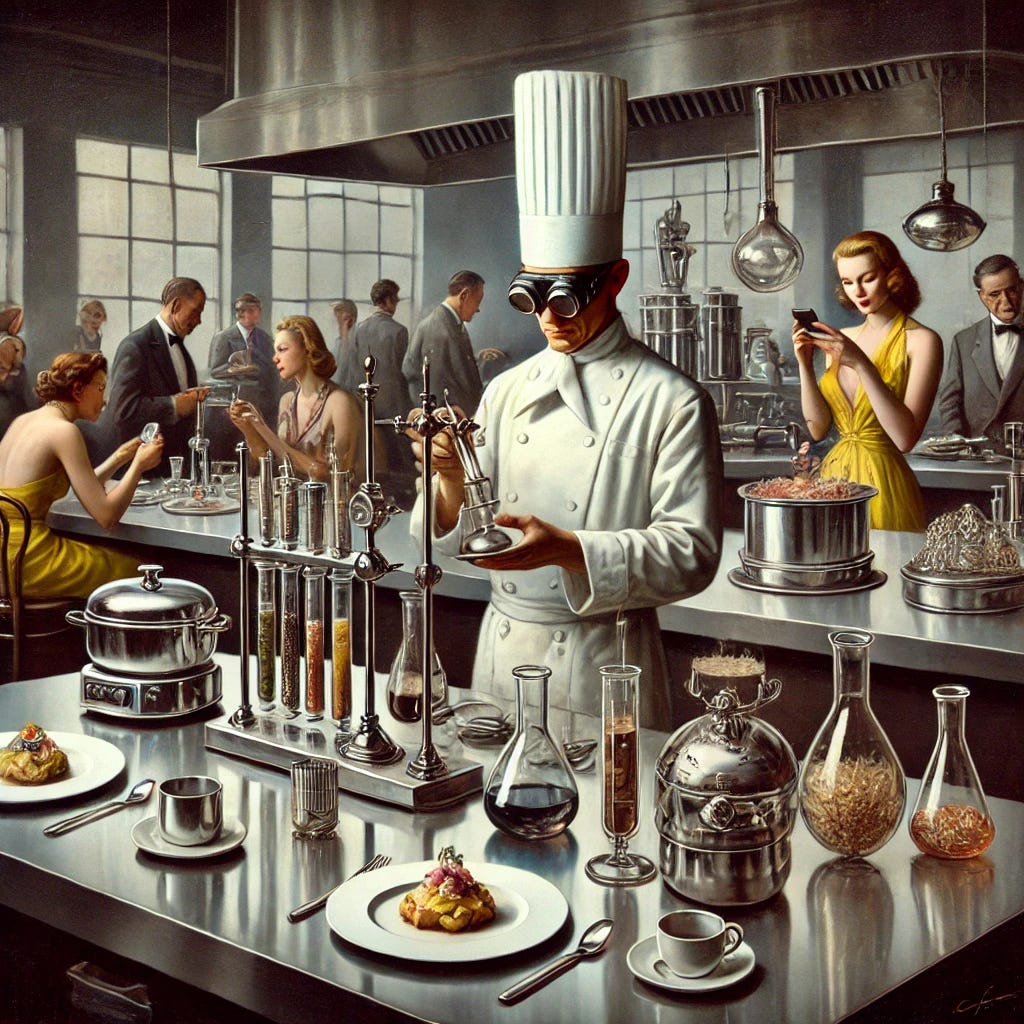On the day before Christmas of 2024, the New York Times published a guest essay by fashionista Katherine K. Zarella titled “Obscene Prices, Declining Quality: Luxury is in a Death Spiral”. Although the essay mostly concerns clothing and accessories, I saw that many of the forces at work had, to a large measure, their counterpart in chefs’ cuisine or high-end dining. They are: Shoddy manufacturing; raising prices far in excess of inflation in spite of an increasing number of consumers having less money to spend; reality TV; social media influencers; outlet malls; and declining hotel service due to staffing shortages. The author invoked the 19th-century Louis Vuitton trunks, early Coco Chanel production; and Dior’s New Look of 1947 as times of “the height of luxury”, a Golden Age of luxury that runs parallel to much of the history of restaurants. To elaborate on this comparison, I couldn’t think of anyone better to write about it than our regular contributor Joerg Zipprick. Not only has he experienced firsthand restaurant gastronomy as a precocious diner starting out in the 1980s, but closely follows the restaurant world as part of his daily life.
Robert Brown
Fine dining has shifted from what could have been called, between the late 1960s and the early 1990s, an extension of the fine arts to become what it is now: another branch of the luxury industry. During the earlier period, chefs focused on elegance and taste, while today's emphasis is often on technique for technique's sake, with many chefs replacing traditional craftsmanship with industrial methods—molecular gastronomy, for example, being little more than a sophisticated rebranding of "cooking" with food additives.
A telling example is sauce preparation: traditionally, a sauce made with stock, alcohol, and cream requires patient reduction through heat—a time-consuming process that develops deep and profound flavors through natural concentration, the stock being, of course, homemade. Today, many chefs simply bind their liquids with xanthan gum, an industrial thickener. While the visual result might be similar, the depth of flavor and craftsmanship are lost. This shortcut epitomizes the broader transformation from time-honored techniques that require skill and patience to industrial solutions that prioritize efficiency and consistency over quality.
Our story begins positively during the "Trente Glorieuses"—thirty years of unprecedented economic growth in France and Europe. This era saw the emergence of Nouvelle Cuisine, perfectly aligned with both growing middle-class prosperity and new lifestyle aspirations. In 1966, William Bowerman, founder of Nike, and cardiologist W. E. Harris published their influential book Jogging, marking the beginning of a global fitness movement. Nouvelle Cuisine’s lighter, more refined approach resonated perfectly with this health-conscious generation while remaining financially accessible to a broad audience of food enthusiasts. The movement’s success stemmed from this powerful combination: increased purchasing power and newfound fitness consciousness. While occasionally marked by excess, this period saw the natural emergence of several great chefs who earned their reputation through talent rather than public relations.
Today's landscape is radically different. Where once fine dining was part of "upper" cultural education along with visiting museums or theaters, it has become a status symbol, like carrying a Hermès Birkin bag. While museums, theater, and opera-going remain relatively accessible, fine dining has become prohibitively expensive, with tasting menus often exceeding $500 per person. These prices create artificial scarcity and exclusivity, often for what has essentially become a mass-market product reliant on industrial techniques.
The business model has shifted accordingly. Traditional restaurants relied on sustainable pricing and regular clientele, with success measured by satisfied returning customers rather than social media buzz. Today's establishments focus on high-markup, bucket-list destination dining, often partnering with luxury brands and groups—unless, of course, the luxury brand is investing in the chef or restaurant from the beginning. The target audience has changed from local food enthusiasts and the culturally curious middle class to wealthy global, luxury-seeking tourists and Instagram influencers. Social media presence mirrors luxury brands' marketing strategies, emphasizing exclusivity and "experiences" over culinary excellence, creating constant pressure for visual innovation rather than taste refinement.
The last twenty years have seen this transformation accelerate. Instead of broad middle-class growth, we are seeing growing wealth inequality reflected in dining rooms. The rise of global ultra-high-net-worth individuals has coincided with the decline of local regular clientele. Wellness itself has become a luxury industry, with food serving as an identity marker and status symbol. This has given rise to a new "foodie" culture, largely detached from traditional gastronomy that required experience and knowledge, and more focused on trendy spots and photo opportunities than on understanding culinary heritage and technique.
With restaurants evolving from serving local communities to catering to global audiences, the emphasis has shifted to spectacle and "Instagrammable" moments. Tasting menus have become the dominant format, not for culinary reasons, but to exert maximum control—including cost control—over the dining experience. Now, storytelling and "philosophy" from the PR department often overshadow and take precedence over taste itself.
This transformation perfectly mirrors what happened in the luxury industry: from craftsmanship-focused houses serving sophisticated clients to global brands selling status symbols. Just as a Prada bag from 30 years ago might be better made than today’s version, many celebrated restaurants of the past focused more on fundamental quality than today’s establishments.
While claiming greater sophistication than ever, many establishments have lost touch with the fundamental elegance and taste-focused approach that characterized the great chefs of previous decades. They are producing "experiences" rather than meals, performances rather than cuisine. If Nouvelle Cuisine reflected societal optimism and democratization, today's fine dining embodies growing inequalities and a focus on appearance over substance.





Great article - It would benefit from naming and shaming restaurants but I guess that is a no-no. Easier to blast rich luxury conglomerates rather than low margin restaurants. I will give this topic a go next week!